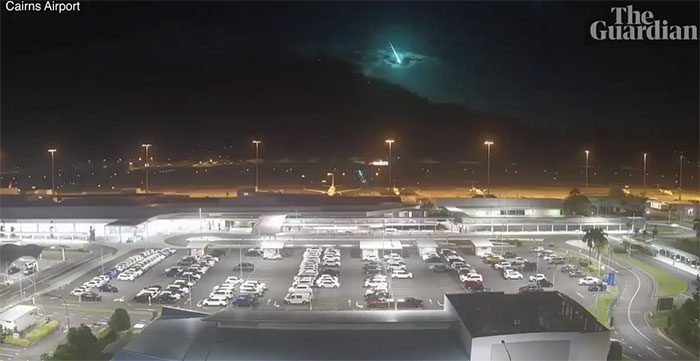The night sky over Queensland, northern Australia, was illuminated on May 20 as a meteor streaked through the atmosphere and crashed to the ground with an enormous sonic boom.
A meteor streaking across the Queensland sky. (Video: Guardian).
Smartphone footage, along with recordings from dashcams and security cameras of businesses and homes from the coastal city of Cairns to Normanton on the Gulf of Carpentaria, captured a large fireball growing in size as it descended closer to the ground, followed by flashes of green and blue light.
Cairns Airport shared colored footage showing the sky flashing green, then yellow, as the meteor passed overhead at 9:22 AM local time on May 20. Residents in the small town of Croydon, about 500 kilometers west of Cairns, reported feeling the explosion and hearing a massive boom.
Dr. Brad Tucker, an astrophysicist at the Australian National University, stated that the rock was likely between 0.5 to 1 meter in size, smaller than average meteors, and was traveling at a speed of 150,000 km/h. The majority of the meteor was composed of chondrite, but in this case, the green color before the explosion was certainly due to iron and nickel fragments overheating as the rock disintegrated before hitting the ground.

A large fireball descends to the ground, followed by flashes of green and blue light.
According to Tucker, this meteor would not create a crater upon impact due to breaking into many pieces before reaching the ground. Although it burned up from friction while falling through the atmosphere, much of the rock remained intact when it hit the ground. “Friction builds up, creating a glow and reaching a breaking point, producing flashes of light and a sonic boom. This explosion is what we are most concerned about with most meteors. It is an explosion in mid-air, but if it occurs above populated areas, it could cause damage. This meteor is quite small, but we are quite worried about meteors that are 10 to 20 meters in size,” Tucker shared.
In 2013, a 20-meter meteor exploded above Chelyabinsk, Russia. Scientists discovered that the rock exploded with energy equivalent to 500 kilotons of TNT. The blast knocked many people off their feet, shattered windows in 3,600 buildings, and caused a factory to collapse. At its peak, the Chelyabinsk meteor was 30 times brighter than the sun, causing skin and retinal burns to people up to 30 kilometers away.





















































